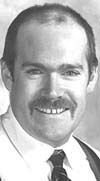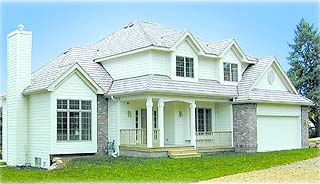
Surveys
DJC.COM
November 15, 2001
Don’t overlook moisture — the silent threat
APA — The Engineered Wood Association

Hayes |
But even diligent homeowners tend to overlook an equally damaging, though less dramatic, danger to a healthy and durable home — excess moisture.
Left unaddressed, moisture problems can lead to costly aesthetic damage to your home (deterioration of finishes), lowered insulation values in your walls (leading to higher energy bills), and degradation of the building itself (including corrosion of nails, staples and braces that hold your house together, and decay of wood framing and sheathing).
And when there is too much moisture in a home, mold and mildew can grow, causing the air in your house to not only smell musty, but in some cases become unhealthy to breathe.
According to the Environmental Protection Agency, indoor air pollution is among the top five environmental risks to public health.
Plus, it’s bad for the economy. Damage from excess water in homes — either from water that enters from the outside, or from moisture generated on the inside — costs the country $9 billion a year, according to Steve Easley, a construction consultant from Danville, Calif.
Two years ago, the city of Seattle completed a survey of multifamily apartments, condos and townhomes and found that of 74 buildings surveyed, 71 reported leaks. The damage estimate is over $100 million.
The problems associated with moisture in homes have prompted new consumer awareness and better building practices efforts around the country.
Demonstration house
In Madison, Wis., APA — The Engineered Wood Association in a unique partnership with the USDA Forest Products Laboratory constructed a moisture-resistant demonstration house to show that proper building techniques and materials can provide a moisture-resistant building envelope.

Photo courtesy of APA — The Engineered Wood Association This demonstration home in Wisconsin will be monitored for 10 years for moisture problems. It features four different types of siding and numerous moisture sensors.
|
Finished just in time for the harsh, Midwestern winter, the home features APA-recommended water-resistive design elements from the foundation to the roof. It is also the first full-scale, finished, research model and will be continuously monitored by the FPL staff to evaluate moisture movement in the building envelope over an extended time.
The house has four types of siding — stucco, brick, panel and lap — all of which were fastened to fully sheathed OSB walls. House wraps, flashing and sealants were carefully installed and the results will offer quantifiable proof to the validity of the construction methods.
“We know how to keep water out of the building envelope,” says Tom Williamson, technical director for APA, “and this house will serve as an educational tool for builders and designers.”
Sensors placed in the home’s walls will measure moisture and temperature variations for the next 10 years. During winter months, the house will be loaded to humidity levels around 40 percent by the FPL researchers, which is higher than typical, to stimulate severe conditions.
The house is just one aspect of APA’s multi-dimensional “Build a Better Home” training program (http://www.buildabetterhome.org). Designed to encourage better building practices and improve building envelope performance, the program includes detailed construction brochures, an instructional video and training seminars.
Moist homes
The APA has also taken the lead in building a government/industry coalition committed to solving a problem that seems to have gained momentum over the last 30 years.
America’s well-intended commitment to energy conservation and increased use of energy-efficient building materials is resulting in airtight houses that are more prone to trap moisture in the building envelope. While leaks from external sources of moisture such as rain and melting snow provide the most obvious threat, inside sources of moisture from showers, laundry rooms and other areas are also a building design consideration.
When problems first started surfacing, most construction experts agreed that the most effective way to avoid moisture build-up was to prevent it from happening with proper ventilation and a design that incorporates effective moisture control.
But the problem couldn’t be blamed entirely on design.
A lack of, or improperly applied moisture control measures were also culpable. Unfortunately, these new moisture problems were coming right on the heels of one of our nation’s longest and busiest building booms. The shortage of experienced framers resulted in construction shortcuts being taken, often because the crews lacked proper training and guidance.
In fact, the biggest sources of leaks found in homes are improper flashing details, improper installation of weather-resistive barriers (such as house wraps) and poorly designed or executed deck-to-wall and wall-to-roof intersections.
APA’s Build a Better Home design recommendations include:
- The use of larger overhangs (18 to 24 inches) to keep rain off of the wall
- Installing a cricket on roof slopes that intersect the plane of the chimney
- Ventilating laundry, kitchen and all baths to the outside
- Installing an air-to-air heat exchanger
- The use of low-e double-pane windows
“We have not reinvented the wheel here,” said Williamson. “Our changes will reduce the threat of moisture intrusion without penalizing the builder or adding significantly to the cost of construction. Most of the materials are specified in the codes to begin with. Knowing how to apply them properly is the key,” he added.
But as long as application problems exist there will be work for contractors like Ron Tatley of Tatley-Grund. His firm fixes leaky buildings and regularly fields calls from architects seeking moisture intrusion design guidance.
“We do all of our own design and fabrication of the flashing material,” said Tatley. “The way different materials interface with the envelope is of critical importance, and not something I want to leave with unqualified personnel. We have a very successful track record with our method,” said Tatley.
Through the Build a Better Home program, it is our desire to see more builders and designers make the same claim.
APA — The Engineered Wood Association (formerly American Plywood Association) is a nonprofit trade association whose domestic and Canadian members produce a variety of engineered wood products. APA’s primary functions are quality inspection and testing, applied research and product promotion.
Other Stories:
- A peek into the architectural process
- Getting a project off the ground
- Head and shoulders above Sea-Tac
- High-rise homes with all the right stuff
- So you’re in it for the money
- What you need to know about your competitors
- Thea’s Landing: Downtown Tacoma’s new urban housing
- Rebirth of a Commencement Bay chateau
- New museum will have Tacomans glassy-eyed
- Beyond the urban core: Learning from the pioneers
- Achieving design certainty through collaboration
- Controlling stormwater the natural way
- Orchestrating Belltown’s rebirth
- Mechanical moxie: Innovations at the new Opera House
- Preserving a church gets personal
- Small housing: A Northwest mini-trend
- Delivering the goods in a tight economy
- Designing a one-building ‘city’ on a Norwegian fjord
- The changing face of retail design
- Preserving affordable housing by design
- A cap over troubled waters
- Hospitality industry draws on refuge and prospect
Copyright ©2009 Seattle Daily Journal and DJC.COM.
Comments? Questions? Contact us.